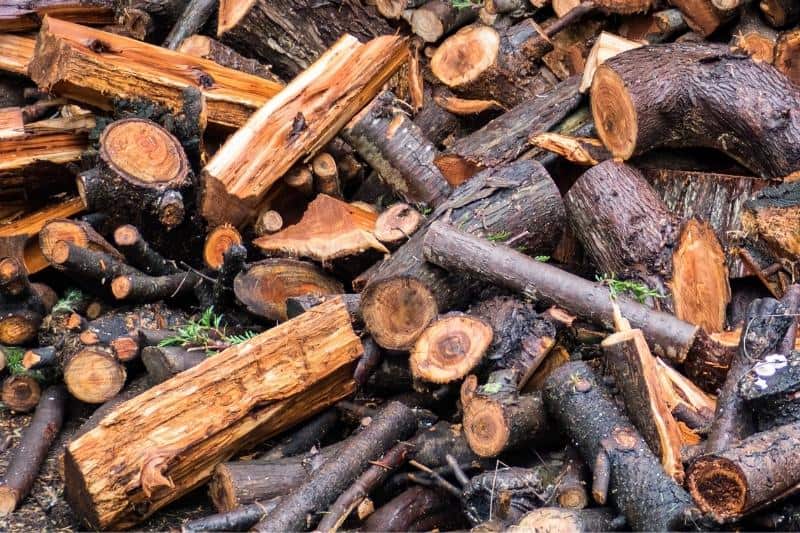How To Dry Firewood Fast?

Table of Contents
Firewood is an essential source of fuel for many households. Properly drying firewood is a crucial part of preparing it for use, as wet wood produces more smoke and less heat when burned than dry wood.
It is important to effectively dry the firewood in order to make the best use of its potential energy output. The following article will discuss how to properly dry firewood quickly and efficiently.
The process of drying firewood can take anywhere from several weeks up to one year, depending on the type of wood being used. There are various methods that have been tested and proven successful in speeding up this process, such as stacking the wood correctly, using a tarp or plastic sheeting, utilizing natural air flow, or storing the logs indoors with a dehumidifier.
Each method has unique benefits that should be taken into consideration when deciding which approach works best.
It is possible to significantly reduce the amount of time required to season firewood by applying proper techniques and understanding the science behind drying processes such as evaporation and convection currents.
Understanding The Moisture Content
The process of drying firewood is largely dependent on the moisture content present in the wood. It should be noted that depending on its source, a piece of wood may contain different levels of moisture.
Therefore, it is important to understand how much moisture is contained within the wood before attempting to dry it. This can be done by using a moisture meter which provides an accurate reading as to how much water is contained in each log or branch.
Once this has been established, one must then decide upon the best method for reducing the amount of water within the logs and branches. There are several techniques available ranging from leaving them out in direct sunlight to artificially drying them with a kiln or through forced air circulation systems.
The most suitable approach will depend on individual circumstances such as local climate, time constraints, and budget considerations. Ultimately, whichever option is chosen, it is essential that all steps necessary for proper drying are closely followed in order to achieve satisfactory results.
Selecting The Right Wood
Choosing the best firewood for drying is akin to a chef selecting only the finest ingredients for their dishes. Just as a masterful meal requires certain types of food, successful and efficient firewood drying depends on the proper selection of wood. The type of tree from which the firewood originates should be considered when deciding whether it will dry quickly or slowly.
Hardwoods are generally thought to be better suited for fast-drying purposes than softwoods because they contain less moisture content upon harvesting. Hardwoods such as oak, ash, hickory, maple, and birch tend to burn hotter and slower than softer woods like pine and fir; however, these softer varieties also produce more creosote buildup in chimneys and flues due to their higher resin content.
This means that while hardwoods may require more time up front, they can provide greater savings down the road since they need less frequent cleaning maintenance compared to those using softer woods.
When picking out firewood for quick drying, one should look for pieces with the bark still intact (if not too thick) and avoid logs that have begun rotting or decaying along the edges. Firewood cuts during winter months will typically take longer to season than those harvested at other times throughout the year due to higher sap levels found within fresh cuts – so make sure you read labels carefully before making your purchase!
Preparing The Firewood For Drying
Before attempting to dry firewood, it is important to prepare the wood for drying. This includes splitting the logs into smaller pieces and stacking them in a way that facilitates air circulation.
If possible, cutting or splitting should be done while the wood is still green so that cracking during drying can be minimized. After cutting, each piece of wood should have at least one end cut flat so that all surfaces are exposed to airflow when stacked.
Additionally, before stacking, any bark on the log should be removed. This will further increase the exposure of the surface area of the wood to airflow and allow moisture to evaporate more quickly.
In addition, removing bark helps reduce insect infestations which may damage the wood over time. When stacking firewood, ensure there is adequate space between layers as this allows hot air flow and accelerates evaporation from both sides of each log simultaneously.
Also, avoid placing stacks directly beneath trees where sap dripping onto logs can cause staining and contamination with organisms from debris falling from branches above. By following these suggestions, it is possible to successfully prepare firewood for drying and achieve fast results.
Ventilation And Air Circulation
Once the firewood is prepared for drying, it is necessary to ensure that proper ventilation and air circulation are in place. Air exchange needs to be adequate in order to assist in reducing moisture content and prevent mold or microbial growth on the wood surface.
Ideally, the location chosen should have enough airflow so that the firewood will dry quickly. For best results, install a fan near an open window or doorway to increase air movement around the area where firewood is stored.
Additionally, creating cross-ventilation with two fans blowing opposite each other can help enhance evaporation from the wood’s surface. Airing out sheds or garages also helps accelerate drying time by providing more fresh air into enclosed areas.
Regularly rotating logs can further aid in drier conditions since this allows even exposure of all sides of a log to moist air, which aids in releasing trapped water vapors from within the timber’s core. Proper venting and air circulation play essential roles not only in helping dried firewood burn better but also in preserving its quality over time.
Temperature Control
The art of firewood drying requires a delicate balance between temperature and humidity. Temperature control is the key to success, as it affects both the speed at which moisture evaporates from wood and also how quickly microbial activity can occur in damp conditions.
It should be noted that although higher temperatures may provide faster results, they carry their own risks: too high a temperature can cause cracks to form on the surface of the wood or even cause fires if not managed properly. Properly controlled temperatures are essential for safe and efficient drying.
To ensure optimal results with minimal risk, it is important to maintain consistent temperatures while drying firewood. This means avoiding sudden changes in temperature during the process; ideally, air should be heated gradually over time until a target temperature has been reached.
The most effective way to accomplish this is by using an enclosed space such as a kiln or solar chamber that traps heat within its walls – allowing for more precise adjustments when needed. Additionally, fans can be used to circulate heated air around larger amounts of wood for quicker evaporation times. By following these steps and monitoring temperatures closely throughout the entire process, one can achieve fast and safe outcomes every time.
Sunlight Exposure
Sunlight exposure is an important factor when attempting to dry firewood quickly. Sunlight can significantly decrease the moisture content of wood, and it also helps prevent mold from forming on the surface.
It is recommended that firewood be placed in a sunny spot for at least two days prior to use. Placing logs in direct sunlight will speed up the drying process even more than if they were just left out in the open air.
In order for this method to work best, however, covering the top of the pile with a tarp or plastic sheeting helps trap heat and accelerates evaporation from the wood’s surface.
Additionally, fanning or stirring the wood periodically ensures all surfaces are exposed equally so that no one area becomes saturated while other areas remain damp. With proper planning and attention to detail, using sunlight exposure as part of your technique can lead to quick results when trying to dry firewood in a hurry.
Wind Exposure
It is often assumed that wind exposure is the best way to dry firewood quickly. However, this is not necessarily true since strong winds can increase the risk of drying too quickly and cause cracks in the wood. On the other hand, mild breezes are beneficial for speeding up the process as they enable better air circulation around the logs.
To take advantage of this method without risking any damage to the wood, it is important to find an open area with light winds blowing regularly. This will guarantee a steady flow of oxygen which helps evaporate moisture from inside the log more efficiently than if there were no airflow at all.
Furthermore, when using wind exposure, it may be necessary to protect your firewood from the rain so it does not become saturated again. Utilizing tarps or covers over stacks of wood can prevent excess moisture from ruining your efforts and setting back progress significantly. In short, while wind exposure can help accelerate drying times, caution must still be taken in order to ensure optimal results.
Stacking And Covering Firewood
Stacking firewood correctly is one of the most important factors for drying wood quickly. Firewood should be stacked with plenty of room between each piece, allowing air to circulate around them and accelerate the drying process.
The stack should not be too high as this can cause instability which may lead to the stack collapsing on itself or blocking airflow. It should also be positioned in a sunny spot away from any trees or buildings that could cast shadows over it and reduce its exposure to sunlight.
Covering firewood is also beneficial when trying to dry it out quickly. A tarpaulin placed securely over the top of the stack will protect it from rain and snow while still allowing access to light and air circulation. If possible, place something underneath the tarp, such as logs or boards so that there is an air gap between them.
This will further increase ventilation throughout the stack and help speed up the drying time even more. In addition, regularly check for condensation buildup beneath the tarp – if water droplets start forming, remove some of the material covering your woodpile until they are gone again.
Dehumidifier Method
The process of drying firewood can be a long and arduous task. To avoid the laboriousness of traditional methods, using a dehumidifier is a great alternative that works quickly to reduce moisture levels in the wood.
Much like an oven dries out cookies ready for consumption, so too does a dehumidifier get rid of excess moisture from wood – only faster. This method will have your logs burning bright before you know it – as fast as lightning!
To begin this process, place the wood indoors near the dehumidifier and ensure that no outside air is entering the area. The reason is outdoor air contains more humidity than indoor air, which could slow down or even reverse any positive progress made by the machine itself.
With doors shut and windows sealed tight, let the dehumidifier run continuously until desired results are achieved, usually around 20-30% moisture content within 24 hours, depending on the size of the pile and intensity of dampness prior to beginning the drying session.
Once these conditions are met, store your firewood in an appropriate location with enough ventilation for further drying over time (at least six months). In doing this, you’ll save yourself plenty of effort while ensuring your logs burn safely when lit later on!
Kiln Method
The Kiln Method is a highly efficient technique to dry firewood rapidly. The process requires the use of an electric kiln with temperature and humidity controls, which can be used to manage air flow throughout the drying chamber.
Firewood must be put into the chamber in stacks that are no more than 16 inches tall, as higher stacks will not have adequate air circulation for effective drying.
The temperature should generally be kept between 120°F – 140°F (49°C – 60°C) depending on species and desired moisture content levels; however, temperatures should never exceed 140°F (60°C). Relative humidity should also remain low, typically less than 20%, as high relative humidity can cause wood cracking or warping due to rapid cooling upon leaving the kiln.
Additionally, all logs need to be manually rotated during the drying process so that all surfaces receive equal exposure to heat and airflow. Drying time depends on species and desired moisture content but is usually around seven days for Red Oak and White Ash at about 18-20% MC.
In order to ensure proper results from using a kiln, it is important to monitor both temperature and relative humidity during the entire process. Maintaining correct settings helps prevent over-drying while ensuring good quality dried firewood free of cracks or warps.
It is also essential to measure moisture content periodically throughout the cycle with a reliable moisture meter in order to determine when each stack has reached its target level before removing it from the kiln chamber.
Benefits Of Dry Firewood
The fire in your hearth brings a unique charm to the atmosphere. However, it is essential that the wood you use must be dry and free of moisture, or else it will not burn properly and produce insufficient heat. To make sure that you enjoy an efficient blaze with maximum heating satisfaction, you should always opt for pre-dried firewood. There are several advantages to using dried wood.
Firstly, burning dry wood produces more heat than wet wood and this makes them ideal for generating warmth during cold winter nights. Moreover, since most of the moisture has been removed from the logs, they tend to burn longer, which means fewer trips outdoors to refill the fireplace. This saves time as well as energy because there’s no need to spend hours splitting new logs into smaller pieces every night before adding them to the existing pile.
In addition, burning dry firewood also reduces smoke production due to fewer unburned fuel particles leaving the chimney. It helps keep air quality safe by eliminating hazardous gases like carbon monoxide from entering indoor spaces while still providing enough warmth throughout each season.
Furthermore, it causes minimal environmental damage since much less amount of smoke is released when compared to the combustion of wet wood – making homes even more eco-friendly!
Disadvantages Of Wet Firewood
Using wet firewood can be very hazardous, especially in a home setting. Wet wood is not as effective for burning and produces far less heat energy than dry wood. As it burns, the water inside the wood creates steam that displaces oxygen from the area around and within the firebox. This lack of sufficient oxygen causes smoke production to increase significantly, producing much more pollution than when using dry wood.
In addition, creosote deposits build up quickly on the interior surfaces of chimneys when combusting wet wood. These deposits are highly flammable and create an increased risk of chimney fires.
Furthermore, due to its higher moisture content compared to dry wood, wet firewood requires much greater effort to transport and handle since it weighs considerably more per unit volume than dry firewood does.
This makes splitting larger pieces difficult and increases labor costs associated with harvesting or collecting firewood. For these reasons, utilizing only properly dried firewood provides improved safety while also optimizing both time and money spent obtaining fuel for home heating purposes.
Conclusion
The process of drying firewood is a crucial step in ensuring that you have an efficient and safe source of heat. Properly dried wood burns more quickly, produces less smoke, and creates fewer creosote deposits which can be dangerous when left unchecked.
Drying firewood also reduces the possibility of mold or bacteria growth from wet wood which could introduce allergens into your home environment. The most effective methods for drying firewood involve ventilation, air circulation, dehumidifiers, and kilns, as these techniques maximize the reduction of moisture content while minimizing the amount of time needed to complete the task.
When done correctly, dry firewood boasts many advantages over its wet counterpart, including increased efficiency due to faster burn times resulting in less wasted fuel; reduced smoke production leading to improved indoor air quality; lower chance of creosote buildup on chimney walls which can cause fires if not regularly maintained; and even savings on energy bills since dryer woods require less fuel to produce adequate heat.
On the other hand, burning wet wood increases emissions such as carbon monoxide and particulate matter which are both hazardous to human health.






